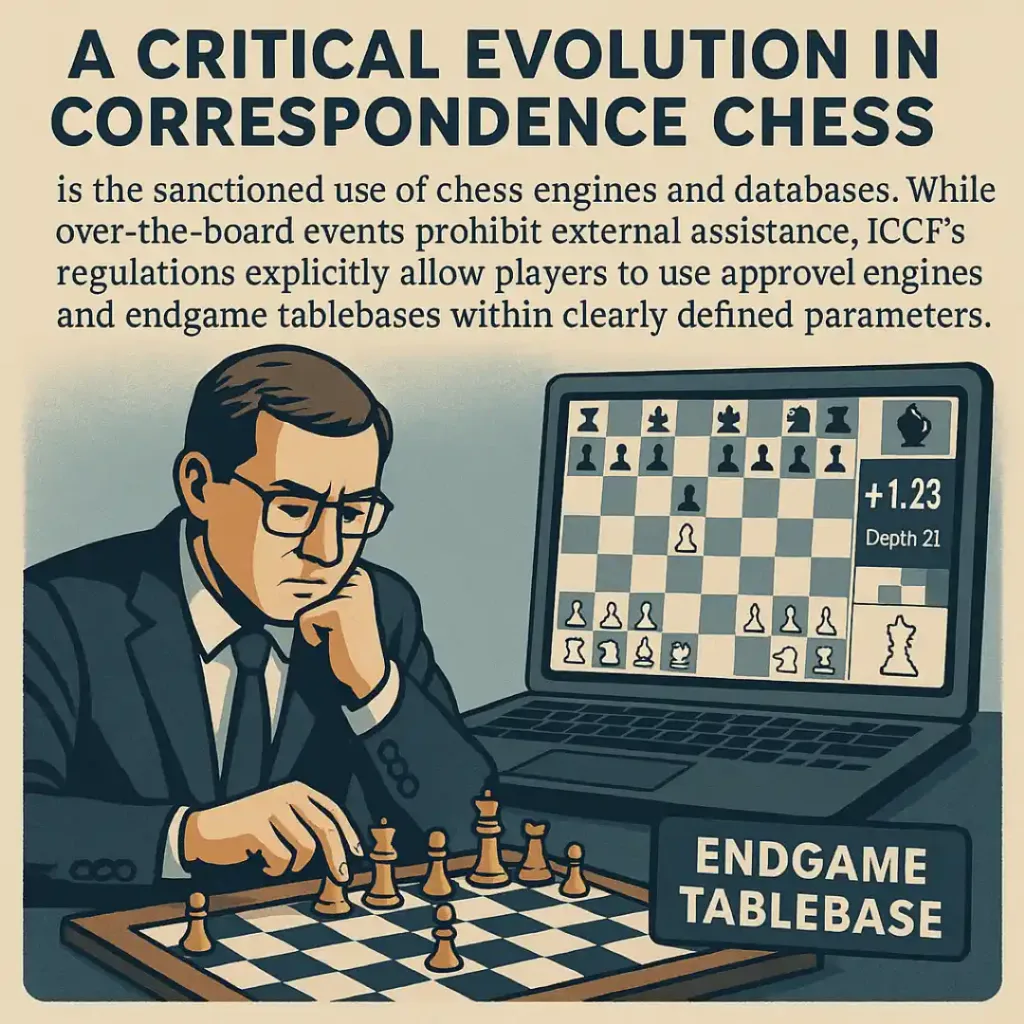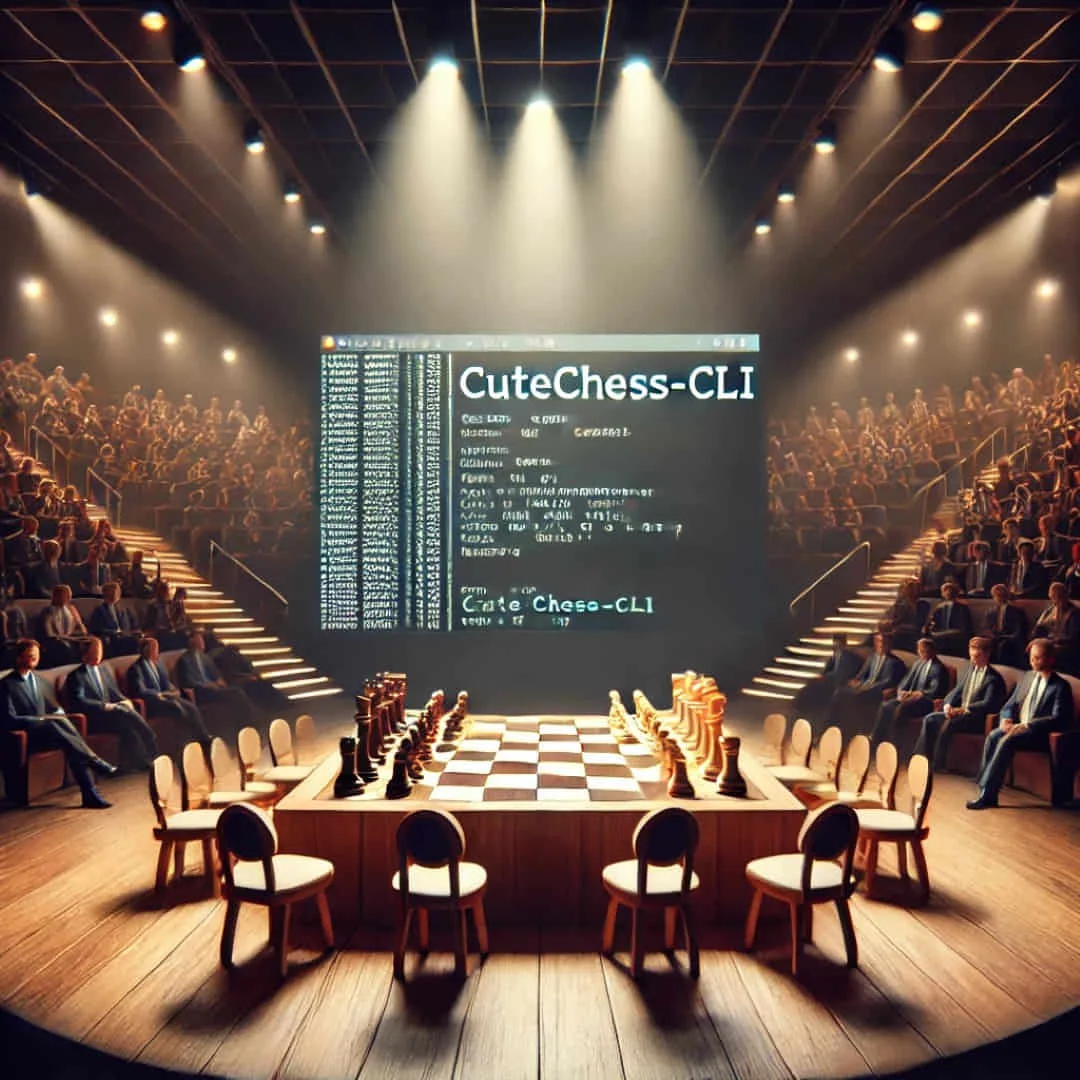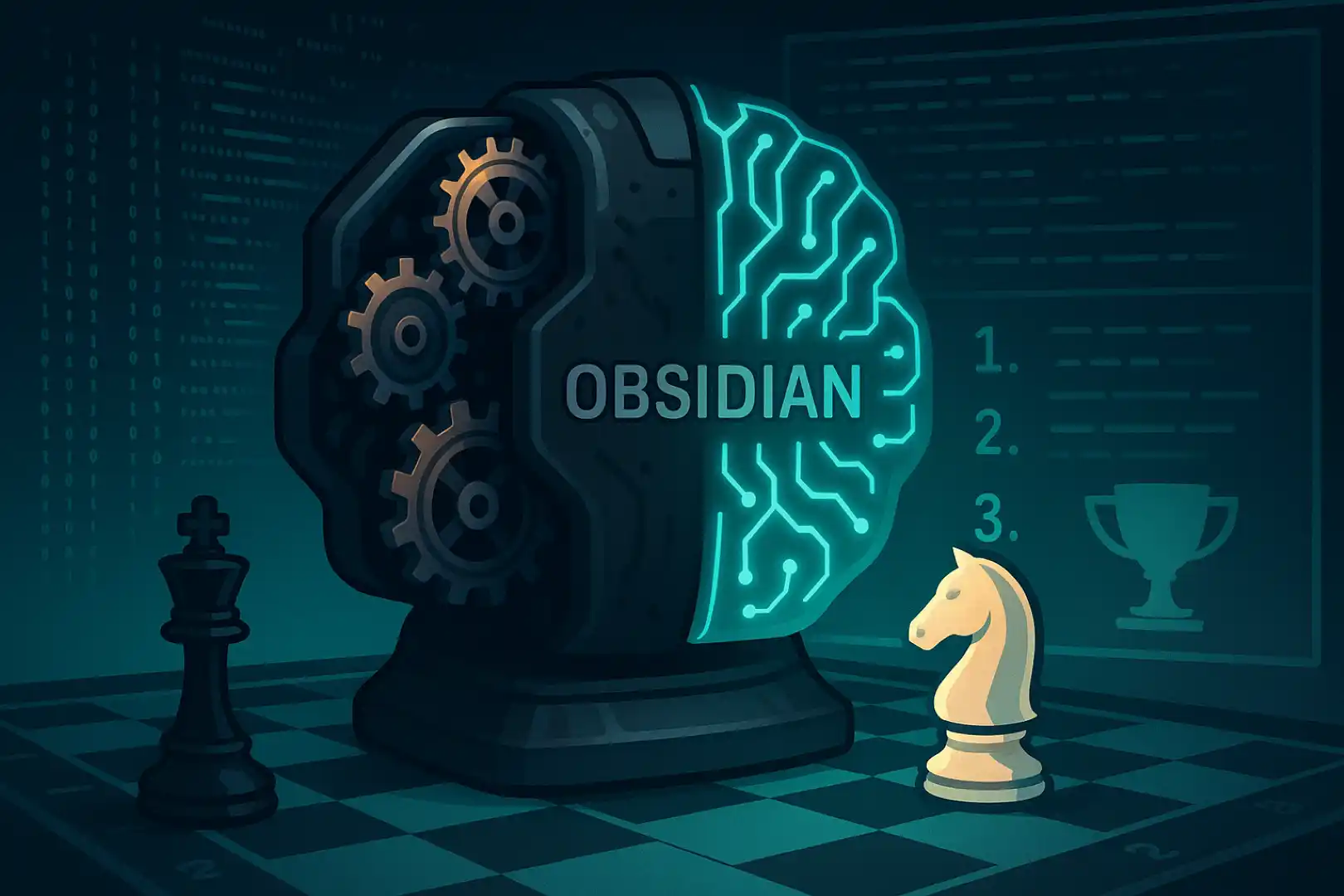Use of Chess Programs in ICCF
Chess Programs in ICCF. The International Correspondence Chess Federation (ICCF) is the global governing body for correspondence chess—chess games played remotely, traditionally by mail and increasingly via online servers. Founded in 1951, the ICCF’s mission is to promote and regulate correspondence chess events across national federations, ensuring fair play, standardized rules, and the awarding of titles and ratings comparable to over-the-board chess. Correspondence chess offers players extended thinking time, often allowing days per move, which encourages deeper strategic analysis and makes the use of dedicated chess software a practical necessity for contemporary competitors.
Correspondence chess has evolved significantly since its postal origins. Traditional postal events could take years to conclude; for example, the 13th ICCF World Championship Final spanned 1989–1998 (Server Chess). Today, ICCF hosts events on its Web server, offering automated move transmission, time controls measured in “moves per days,” and standardized adjudication procedures. The 2024 ICCF Rules codify these procedures, covering everything from time controls to conduct, tournament organization, and the role of a Tournament Director (TD) or Tournament Management Committee (TMC) .
A critical evolution in correspondence chess is the sanctioned use of chess engines and databases. While over-the-board events prohibit external assistance, ICCF’s regulations explicitly allow players to use approved engines and endgame tablebases within clearly defined parameters. This reflects the ICCF’s recognition that deep analysis tools are integral to high‐level correspondence play and that restricting them would stifle the very expertise correspondence chess seeks to showcase. The federation maintains strict rules on software use, requiring that any engine be commercially available or open‐source and forbidding engines that rely on unauthorized human training data or proprietary opening books beyond licensed databases.
This article explores:
- The types of tournaments organized by ICCF and their formats
- The role of chess programs and endgame tablebases in different event types
- The calculation of ICCF ratings (Elo)
- Historical champions in a comprehensive table
- The federation’s current activities and future outlook
By examining the ICCF’s structures, regulations, and championship history, we gain insight into how technology complements human ingenuity in correspondence chess, driving new standards of analytical depth and competitive fairness.
tournament types
ICCF events are organized into several major categories, each with its own structure, eligibility requirements, and time controls. According to the ICCF Events Announcements page, the principal tournament types include:
- Open Tournaments
- Webchess Opens: Triple‐block format, open to all titled and non-titled players, rated on the ICCF server. Typically 6–7 players per section with 50 days per 10 moves plus increment (ICCF).
- Free Two‐Game Matches (FM): Designed to introduce new players to ICCF’s server interface; unrated, two‐game mini-matches with standard time controls.
- World Championship Cycle
- Preliminaries (WCCC-Prel): National qualifiers leading to the international stage.
- Semi-Finals (WCCC-SF): Groups of 13–15 players; the top scorers advance.
- Candidates: Typically round-robin with 14 players; qualifiers for the Final.
- Final: The decisive round-robin determining the corresponding world champion .
- Norm Tournaments
- Groups labeled A and B (e.g., WS/CCE/A, WS/CCE/B) offering norms toward ICCF titles (e.g., International Master, Grandmaster).
- Typically 14–17 players, 10 moves in 50 days per move.
- Promotion Tournaments
- Server-Based (WS/H, WS/M, WS/O): Offer promotion to higher event levels; rated, small groups (6–11 players).
- Postal (WT/A, WT/O): Similar format on the postal server, with longer response times (10 moves in 40 days).
- Super-Regional Tournaments
- European and “Rest of World” Championships: Multi‐stage events, including preliminaries and open rounds at both server and postal formats.
- Aspirer and Thematic Tournaments
- Aspirer: For lower‐rated players to gain experience.
- Thematic: All games begin from a chosen opening position (e.g., Philidor Defence, Marshall Attack).
- Chess 960 and Team Events
- Chess 960: Randomized starting positions.
- Team Matches and Olympiads: National teams compete in correspondence format, with TD oversight.
Each tournament type balances accessibility and competitive rigor. Open Tournaments broaden participation, while the World Championship Cycle emphasizes the elite level. Norm Tournaments serve as stepping stones to ICCF titles, and Promotion Tournaments offer a ladder to advance through event tiers. The ICCF calendar ensures continuous opportunities for players of all strengths, fostering growth and maintaining high competitive standards (ICCF).
A hallmark of modern correspondence chess is the sanctioned use of computational assistance. However, the scope of allowed tools varies across event types:
- World Championship and Norm Tournaments
- Engines: Permitted without human consultation. Players may run multiple engines in parallel, provided each is commercially licensed or open‐source.
- Databases: Players can reference opening books and game collections, but all resources must be publicly available or legally owned.
- Endgame Tablebases: Fully allowed; ICCF recognizes up to seven-piece tablebases for precise endgame analysis.
- Restrictions: No use of “live” assistance from third parties; all analysis must be performed by the player using their own machines.
- Open and Aspirer Tournaments
- Generally mirror the above rules, with slightly shorter time controls.
- Thematic events also permit full engine use, as opening variability is constrained by theme.
- Free Two-Game Matches
- Engine use: Generally discouraged to simulate novice conditions, but not strictly forbidden.
- Chess 960
- Engine use: Fully allowed, recognizing the equalizing nature of randomized positions.
- Team Events & Olympiads
- Sharing: Players on the same national team may share analysis amongst teammates, but collusion rules prohibit undisclosed cooperation.
- The TD or TMC monitors suspiciously homogeneous analysis patterns and may call for adjudications on draw offers or “Dead Man’s Defense” scenarios .

Endgame tablebases
The ICCF Rules (2024) codify these differences explicitly in Sections 1.2 and 3.14.3, ensuring that engine‐assisted play remains fair and transparent. Endgame tablebases have revolutionized correspondence chess by eliminating theoretical errors in endgames. Players routinely verify six- and seven-piece endings, pushing the competitive standard beyond human capacity in closing positions.
In norm and title tournaments, the depth of allowed computational analysis underscores correspondence chess’s distinct identity: rather than testing memory or over-the-board nerves, ICCF events challenge players’ ability to harness and interpret vast analytical data. This symbiosis of human strategic judgment and machine precision has propelled correspondence chess to new creative heights, with novel opening novelties and refined endgame studies emerging from top-level ICCF play.
ICCF employs a dedicated Elo‐based rating system reflecting long time controls and engine‐assisted play. Key elements include:
- Rating Formula
- Based on the standard Elo expectation model:
EA=11+10(RB−RA)/400E_A = \frac{1}{1 + 10^{(R_B – R_A)/400}}
where RA,RBR_A, R_B are player ratings and EAE_A is A’s expected score. - Post‐tournament rating change:
RA′=RA+K×(SA−EA)R’_A = R_A + K \times (S_A – E_A)
where SAS_A is the actual score, and KK is the development coefficient.
- Based on the standard Elo expectation model:
- K‐Factor Adjustments
- New players (rating <2000 or <30 games) use K=40 for rapid stabilization.
- Established players use K=20; top players (>2500) use K=10 to reflect rating maturity .
- Rating Categories
- ICCF ratings range from under-2000 for aspirers to Grandmaster norms requiring performance ratings >2600.
- Title norms (IM, SIM, GM) require performance across multiple tournaments, with norms awarded for high‐performance scores in norm events (e.g., ≥66% against titled opposition).
- Rating Publication
- Updated quarterly; available on the ICCF website under “ICCF Ratings.”
- Separate ratings for server and postal events, reflecting different error rates and adjudication frequencies.
- International Titles
- Awarded based on norm accumulation and minimum rating thresholds:
- ICCF International Master (IM): ≥2450 performance in norm events.
- Senior International Master (SIM): ≥2550 performance.
- Correspondence Grandmaster (GM): ≥2600 performance and three GM norms .
- Awarded based on norm accumulation and minimum rating thresholds:
This meticulous rating methodology ensures players are measured by consistent statistical models, accounting for the engine‐augmented precision of play. ICCF’s Appendix 1 (Rating System) and Appendix 2 (Title Requirements) provide exhaustive details.
World Correspondence Chess Champions
Below is a comprehensive table of ICCF World Correspondence Chess Champions from the inaugural event (1950–1953) through the 32nd Final (2020–2022). Note: the 33rd Final (2022–) is ongoing as of May 2025.
| No. | Years | Champion | Federation |
|---|---|---|---|
| 1 | 1950–1953 | Cecil J. S. Purdy | Australia |
| 2 | 1956–1959 | Vyacheslav Ragozin | USSR |
| 3 | 1959–1962 | Alberic O’Kelly | Belgium |
| 4 | 1962–1965 | Vladimir Zagarovsky | USSR |
| 5 | 1965–1968 | Hans Berliner | USA |
| 6 | 1968–1971 | Horst Rittner | Germany |
| 7 | 1972–1976 | Yakov Estrin | USSR |
| 8 | 1975–1980 | Jørn Sloth | Denmark |
| 9 | 1977–1983 | Tõnu Õim | Estonia |
| 10 | 1978–1984 | Viktor V. Palciauskas | USA |
| 11 | 1981–1987 | Fritz Baumbach | Germany |
| 12 | 1984–1990 | Grigory Sanakoev | USSR |
| 13 | 1989–1998 | Mikhail Umansky | Russia |
| 14 | 1994–1999 | Tõnu Õim | Estonia |
| 15 | 1996–2002 | Gert Jan Timmerman | Netherlands |
| 16 | 1999–2004 | Tunc Hamarat | Austria |
| 17 | 2002–2007 | Ivar Bern | Norway |
| 18 | 2003–2005 | Joop van Oosterom | Netherlands |
| 19 | 2004–2007 | Christophe Léotard | France |
| 20 | 2004–2011 | Pertti Lehikoinen | Finland |
| 21 | 2005–2008 | Joop van Oosterom | Netherlands |
| 22 | 2007–2010 | Aleksandr Dronov | Russia |
| 23 | 2007–2011 | Ulrich Stephan | Germany |
| 24 | 2009–2012 | Marjan Šemrl | Slovenia |
| 25 | 2009–2013 | Fabio Finocchiaro | Italy |
| 26 | 2010–2015 | Ron Langeveld | Netherlands |
| 27 | 2011–2014 | Aleksandr Dronov | Russia |
| 28 | 2013–2017 | Leonardo Ljubičić | Croatia |
| 29 | 2015–2018 | Aleksandr Dronov | Russia |
| 30 | 2017–2019 | Andrey Kochemasov | Russia |
| 31 | 2019–2022 | Ron Langeveld; Christian Muck; Fabian Stanach | Netherlands, Austria, Poland |
| 32 | 2020–2022 | Jon Edwards | USA |
Source: Complete list of ICCF Correspondence Chess Champions (Server Chess)
As of May 2025, the ICCF continues to expand its digital infrastructure, with over 15,000 active players from more than 60 member federations. The ICCF Webserver, launched in 2011, remains the primary platform for correspondence events, offering:
- Real-time adjudication and standings updates
- Integrated endgame tablebase support
- Automated time‐control enforcement
- Secure data handling in compliance with GDPR .
Member federations organize national championships, with top performers earning places in international preliminaries. The ICCF Congress, held biennially, sets future regulatory directions, including:
- AI fairness initiatives, ensuring engine assistance remains standardized
- Enhanced server security, protecting against bot abuse
- Expansion of thematic and rapid (triple-block) events to attract younger players.
ICCF’s partnership with endgame tablebase providers and chess‐engine developers ensures players have access to the latest analytical tools. Educational webinars on “Effective Engine Use” and “Advanced Endgame Techniques” have become regular features, further professionalizing correspondence play.
Looking ahead, ICCF aims to:
- Integrate cloud‐based analysis platforms directly into its server.
- Launch mobile apps for on‐the-go move submissions.
- Develop AI‐driven anti-cheating algorithms to detect irregular engine usage patterns.
- Broaden outreach through social media and streaming of top‐level games.
By balancing technological innovation with fair‐play regulations, the ICCF ensures that correspondence chess remains a vibrant, intellectually rigorous pursuit for players worldwide. The synergy of human creativity and computational power will continue to define the future of ICCF competitions, keeping correspondence chess at the cutting edge of the modern chess landscape.
Bibliography
- International Correspondence Chess Federation. ICCF Rules (Valid from 1 January 2024). ICCF, 31 Dec 2023.
- ICCF. Events & Announcements. Accessed May 2025. (ICCF)
- “Archive: Complete List of World Correspondence Chess Champions.” CCLA ServerChess, 2005. (Server Chess)
- ICCF. ICCF Ratings. https://www.iccf.com/Ratings.aspx (accessed May 2025).
- ICCF. Endgame Tablebases. https://www.iccf.com/TableBases.aspx (accessed May 2025).

Jorge Ruiz Centelles
Filólogo y amante de la antropología social africana



